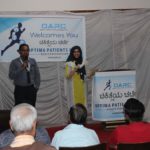Overview
An ACL injury is a tear or sprain of the anterior cruciate (KROO-she-ate) ligament (ACL) — one of the major ligaments in your knee. ACL injuries most commonly occur during sports that involve sudden stops or changes in direction, jumping and landing — such as soccer, basketball, football and downhill skiing.
Many people hear or feel a “pop” in the knee when an ACL injury occurs. Your knee may swell, feel unstable and become too painful to bear weight.
Depending on the severity of your ACL injury, treatment may include rest and rehabilitation exercises to help you regain strength and stability or surgery to replace the torn ligament followed by rehabilitation. A proper training program may help reduce the risk of an ACL injury.
Symptoms
Signs and symptoms of an ACL injury usually include:
A loud “pop” or a “popping” sensation in the knee
Severe pain and inability to continue activity
Rapid swelling
Loss of range of motion
A feeling of instability or “giving way” with weight bearing
When to see a doctor
Seek immediate care if any injury to your knee causes signs or symptoms of an ACL injury. The knee joint is a complex structure of bones, ligaments, tendons and other tissues that work together. It’s important to get a prompt and accurate diagnosis to determine the severity of the injury and get proper treatment.
Causes
Ligaments are strong bands of tissue that connect one bone to another. The ACL, one of two ligaments that cross in the middle of the knee, connects your thighbone (femur) to your shinbone
(tibia) and helps stabilize your knee joint.
ACL injuries often happen during sports and fitness activities that can put stress on the knee:
Suddenly slowing down and changing direction (cutting)
Pivoting with your foot firmly planted
Landing awkwardly from a jump
Stopping suddenly
Receiving a direct blow to the knee or collision, such as a football tackle
When the ligament is damaged, there is usually a partial or complete tear of the tissue. A mild injury may stretch the ligament but leave it intact.
Risk factors
There are a number of factors that increase your risk of an ACL injury, including:
Being female — possibly due to differences in anatomy, muscle strength and hormonal influences
Participating in certain sports, such as soccer, football, basketball, gymnastics and downhill skiing
Poor conditioning
Wearing footwear that doesn’t fit properly
Using poorly maintained sports equipment, such as ski bindings that aren’t adjusted properly Playing on artificial turf surfaces
Complications
People who experience an ACL injury are at higher risk of developing osteoarthritis in the knee.
Arthritis may occur even if you have surgery to reconstruct the ligament.
Multiple factors likely influence the risk of arthritis, such as the severity of the original injury, the presence of related injuries in the knee joint or the level of activity after treatment.
Prevention
Proper training and exercise can help reduce the risk of ACL injury. A sports medicine physician, physical therapist, athletic trainer or other specialist in sports medicine can provide assessment, instruction and feedback that can help you reduce risks. Programs to reduce ACL injury include:
Exercises that strengthen leg muscles, particularly hamstring exercises, to ensure an overall balance in leg muscle strength
Exercises to strengthen the core, including the hips, pelvis and lower abdomen
Training and exercise emphasizing proper technique and knee position when jumping and landing from jumps
Training to improve technique when performing pivoting and cutting movements
Training to strengthen muscles of the legs, hips and core — as well as training to improve jumping and landing techniques — may help to reduce the higher ACL injury risk associated with women athletes.
Gear
Wear footwear and padding that is appropriate for your sport to help prevent injury. If you downhill ski, make sure your ski bindings are adjusted correctly by a trained professional so that your skis will release appropriately if you fall.
Wearing a knee brace doesn’t appear to prevent ACL injury or reduce the risk of recurring injury after surgery.
Any use of this site constitutes your agreement to the Terms and Conditions and Privacy Policy linked below.
Mayo Clinic is a nonprofit organization and proceeds from Web advertising help support our mission. Mayo Clinic does not endorse any of the third party products and services advertised.
Advertising and sponsorship policy
Advertising and sponsorship opportunities
A single copy of these materials may be reprinted for noncommercial personal use only. “Mayo,” “Mayo Clinic,” “MayoClinic.org,” “Mayo Clinic Healthy Living,” and the triple-shield Mayo Clinic logo are trademarks of Mayo Foundation for Medical Education and Research.
© 1998-2019 Mayo Foundation for Medical Education and Research (MFMER). All rights reserved.













